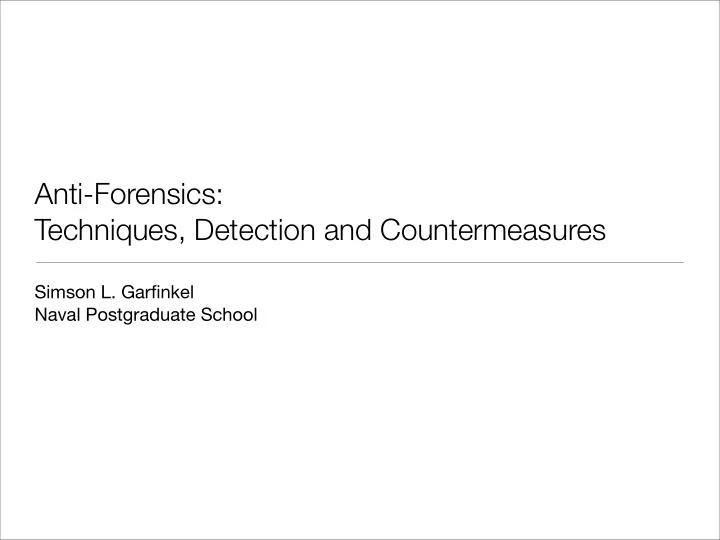

Anti-Forensics: Techniques, Detection and Countermeasures Simson L. Garfinkel Naval Postgraduate School
What is Anti-Forensics? Computer Forensics: “Scientific Knowledge for collecting, analyzing, and presenting evidence to the courts” (USCERT 2005) Anti-Forensics: tools and techniques that frustrate forensic tools, investigations and investigators Goals of Anti-Forensics: • Avoiding detection • Disrupting information collection • Increasing the examiner’s time • Casting doubt on a forensic report or testimony (Liu and Brown, 2006) • Forcing a tool to reveal its presence • Subverting the tool — using it to attack the examiner or organization • Leaving no evidence that the AF tool has been run
One traditional Anti-Forensic technique is to overwrite or otherwise destroy data. Overwriting: Eliminate data or metadata (e.g. disk sanitizers, Microsoft Word metadata “washers,” timestamp eliminators.) Disk Sanitizers; Free Space Sanitizers; File Shredders • Microsoft Remove Hidden Data Tool ; cipher.exe; ccleaner Metadata Erasers • Example: timestomp Hard problem: What should be overwritten?
Anti-Forensic tools can hide data with cryptography or steganography. • Cryptographic File Systems (EFS, TrueCrypt) • Encrypted Network Protocols (SSL, SSH, Onion Routing*) • Program Packers (PECompact, Burneye) & Rootkits • Steganography • Data Hiding in File System Structures • Slacker — Hides data in slack space • FragFS — Hides in NTFS Master File Table • RuneFS — Stores data in “bad blocks” • KY FS — Stores data in directories • Data Mule FS — Stores in inode reserved space • Host Protected Areas & Device Configuration Overlay *Onion routing also protects from traffic analysis
Anti-Forensics 3: Minimizing the Footprint Overwriting and Data Hiding are easy to detect. • Tools leave tell-tale signs; examiners know what to look for. • Statistical properties are different after data is overwritten or hidden. AF tools that minimize footprint avoiding leaving traces for later analysis. • Memory injection and syscall proxying • Live CDs, Bootable USB Tokens • Virtual Machines • Anonymous Identities and Storage (don’t worry; we have slides for each of these)
Memory Injection and Userland Execve: Running a program without loading the code. Memory Injection loads code without having the code on the disk. • Buffer overflow exploits — run code supplied as (oversized) input Userland Execve — Runs program without using execve() — Bypasses logging and access control — Works with code from disk or read from network
Syscall proxying: Running a program without the code! Syscall Proxying • Program runs on one computer, syscalls executed on another. • Program not available for analysis • May generate a lot of network traffic • Developed by Core Security; used in Impact Client Application Server Application Client server stub stub Client server Network runtime runtime Client Kernel Server Kernel
Live CDs, Bootable USB Tokens, Virtual Machines: Running code without leaving a trace. Most forensic information is left in the file system of the running computer. These approaches keep the attacker’s file system segregated: — In RAM (CDs & Bootable USB Tokens) — In the Virtual Machine file (where it can be securely deleted)
Anonymous Identities and Storage: The attacker’s data may be anywhere. Attackers have long made use of anonymous e-mail accounts. Today these accounts are far more powerful. • Yahoo and GMail both have 2GB of storage • APIs allow this storage to be used as if it were a file system Amazon’s Elastic Compute Cloud (EC2) and Simple Storage Service (S3) provide high-capability, little-patrolled services to anyone with a credit card • EC2: 10 ¢/CPU hour (Xen-based virtual machines) • S3: 10 ¢/GB-Month With BGP , it’s possible to have “anonymous IP addresses.” 1. Announce BGP route 2. Conduct attack 3. Withdraw BGP address Being used by spammers today (http://www.nanog.org/mtg-0602/pdf/feamster.pdf)
Attacking the Investigator: AF techniques that exploit CFT bugs. Craft packets to exploit buffer-overflow bugs in network monitoring programs like tcpdump , snort and ethereal. Create files that cause EnCase to crash. Successful attacks provide: ➡ Ability to run code on the forensic appliance ➡ Erase collected evidence ➡ Break the investigative software ➡ Leak information about the analyst or the investigation ➡ Implicate the investigator
Attacking the Investigator: Denial-of-Service Attacks against the CFT Any CFT resource whose use is determined by input can be overwhelmed. • Create millions of files or identities • Overwhelm the logging facility • Compression bombs — 42.zip The clever adversary will combine this chaff with real data, e.g.: Chaff 100 215 Real 54 500 TB TB Data TB TB A B C D
Anti-Forensic Tools can detect Computer Forensic Tools: cat-and-mouse. SMART (Self-Monitoring, Analysis and Reporting Technology) drives report: • Total number of power cycles • Total time hard drive has been on Network Forensics can be detected with: • Hosts in “promiscuous” mode responding differently — to PINGs. — to malformed packets — to ARPs • Hosts responding to traffic not intended to them (MAC vs. IP address) • Reverse DNS queries for packets sent to unused IP addresses to: 192.168.1.250 from: 64.3.20.100 Attacker who is 64.3.20.100? 192.168.1.10
Countermeasures for Anti-Forensics Improve the tools — many CFTs are poorly written. Save data where the attacker can’t get at it: — Log hosts — CD-Rs Develop new tools: — Defeat encrypted file systems with keyloggers. — Augment network sniffers with traffic analysis
Find out more at the Forensics Wiki: http://www.forensicswiki.org/
In Conclusion: • Many forensic techniques in use today can be circumvented • Circumvention tools are widely available • Common approaches: • Overwriting data • Encrypting data • Anonymous identities & resources • Exploit bugs in computer forensic tools to hide • New approaches: • Minimizing or eliminating memory footprints • Virtual machines • Direct attacks against computer forensic tools http://www.simson.net/ref/2007/ICIW.pdf
Recommend
More recommend